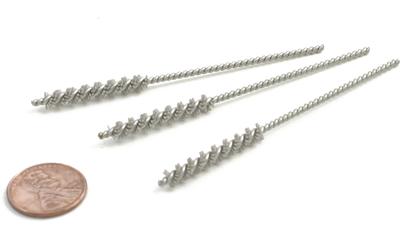
Removing burrs and producing an edge radius on small-diameter holes is an expensive finishing problem that involves a great deal of hand work, according to Brush Research Manufacturing Co. Inc. The company reports that its miniature deburring brushes can automate this process, saving time and money while improving product quality and consistency.
Filament choices include carbon steel, stainless steel, brass, nylon and natural to provide the optimal finish on a variety of base materials. Miniature deburring brushes in a diamond abrasive-filled nylon filament are also available for finishing ceramic, glass, aerospace alloys and tool steel. The advantage of diamond abrasive nylon is that it will cut harder materials, deburr faster and last longer, according to the company. Brushes for through-holes (81 series) are available for holes as small as 0.024" (0.6mm) in diameter. Brushes for bottom-end applications are available for holes as small as 1⁄8" (3.2mm). BRM also offers a metric series starting at 1mm. Filament choice depends on the base material being finished, the severity of the burr and the final finish required. Carbon steel and stainless steel filament brushes are effective in cast iron and steel to remove chips and breakout burrs. Abrasive-filled nylon is effective for improving surface finish and reducing burrs in softer materials and is a good choice for deburring threads in both steel and aluminum. Brass filaments are excellent for soft materials. Nylon and natural filaments are mainly used for cleaning. Both can be used as a carrier for a diamond paste or cutting compound for polishing applications. Miniature twisted-in-wire deburring brushes can be used by hand or rotated under power. The smallest diameter brushes are most often used by hand due to the delicate nature of the stem. Holders and pin vises are often used to grip the stem wire on the smallest tools. The larger diameter brushes can be chucked directly onto the stem wire and driven under power. Typical rpm for this type of product is 800 to 1,100. Twisted-in-wire brushes should never be rotated faster than 1,200 rpm. For most applications, the brushes can be used with cutting fluid or dry.
Contact Details
Related Glossary Terms
- abrasive
abrasive
Substance used for grinding, honing, lapping, superfinishing and polishing. Examples include garnet, emery, corundum, silicon carbide, cubic boron nitride and diamond in various grit sizes.
- alloys
alloys
Substances having metallic properties and being composed of two or more chemical elements of which at least one is a metal.
- burr
burr
Stringy portions of material formed on workpiece edges during machining. Often sharp. Can be removed with hand files, abrasive wheels or belts, wire wheels, abrasive-fiber brushes, waterjet equipment or other methods.
- cutting fluid
cutting fluid
Liquid used to improve workpiece machinability, enhance tool life, flush out chips and machining debris, and cool the workpiece and tool. Three basic types are: straight oils; soluble oils, which emulsify in water; and synthetic fluids, which are water-based chemical solutions having no oil. See coolant; semisynthetic cutting fluid; soluble-oil cutting fluid; synthetic cutting fluid.
- polishing
polishing
Abrasive process that improves surface finish and blends contours. Abrasive particles attached to a flexible backing abrade the workpiece.
